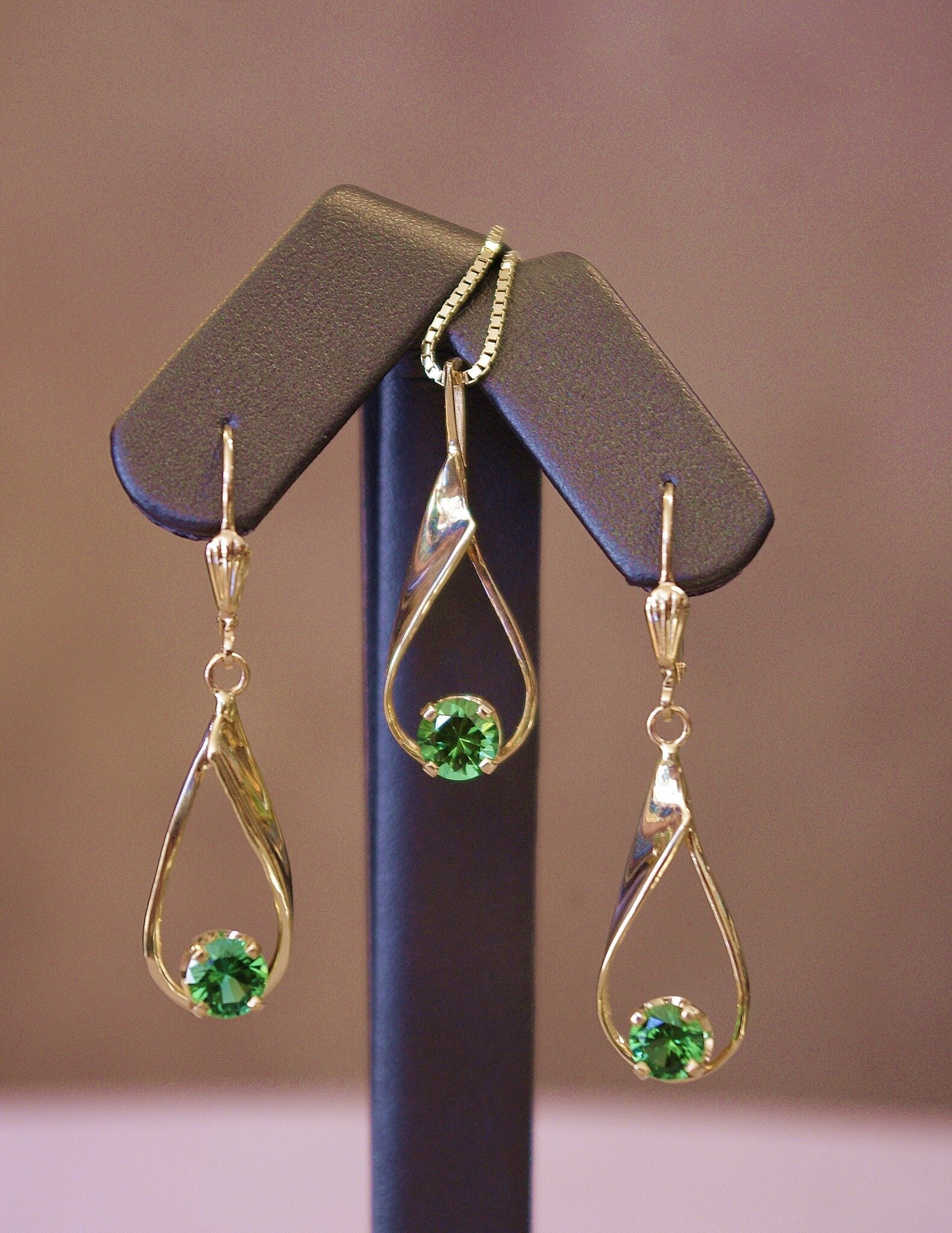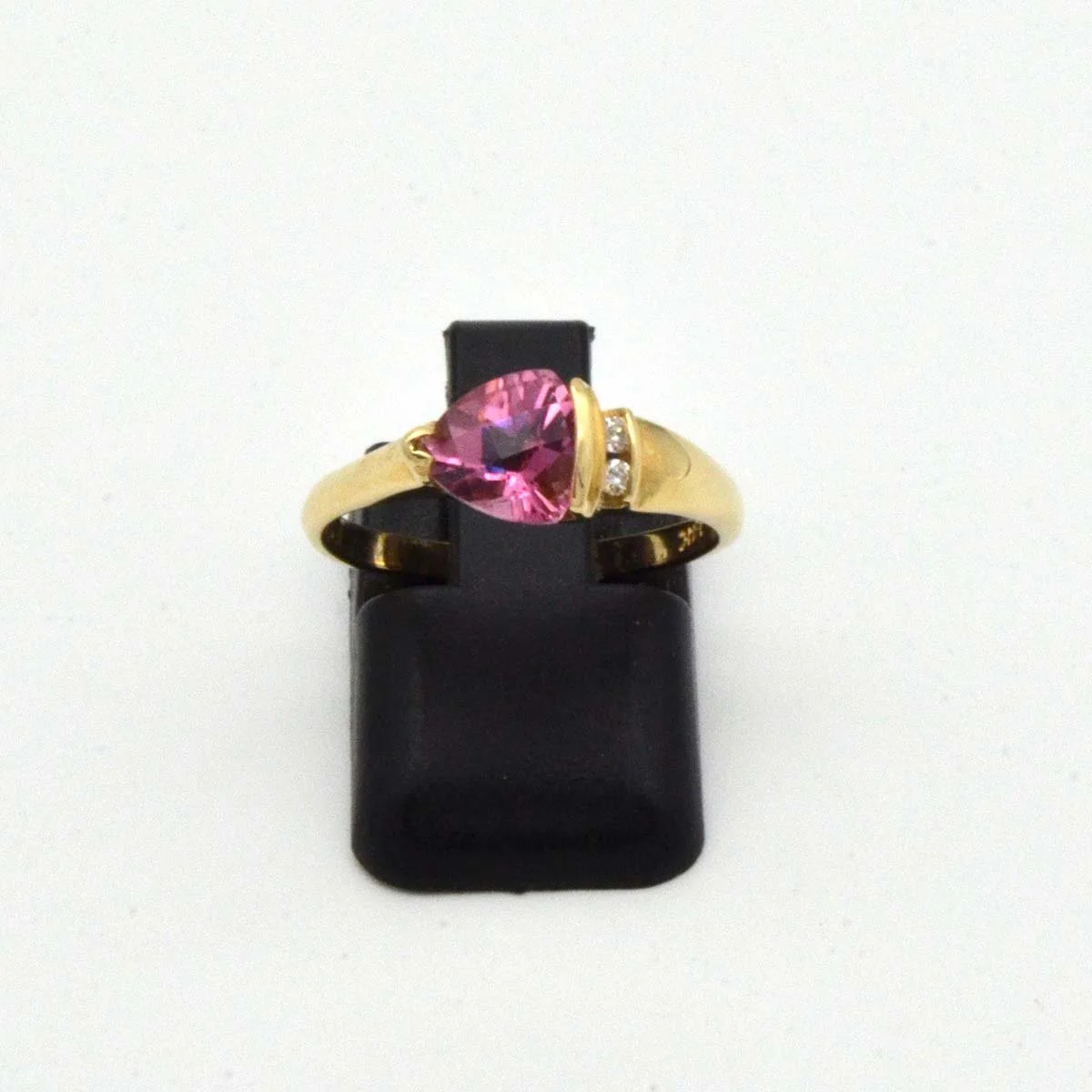Tourmaline
Tourmaline is the newer October birthstone. The name comes from the Sinhalese word “toramalli”, which means “stone with mixed colors”, because it often has multiple colors in one crystal. Very few gems match tourmaline’s dazzling array of colors. Perhaps this is why ancient mystics believed this October birthstone could inspire artistic expression – it has a color palette for every mood. Among the most popular are the pink and red rubellites, the emerald green “chrome” tourmalines, and the neon green and blue-to-violet “Paraiba” tourmalines.
Definition:
Tourmaline’s colors have many different causes. It’s generally agreed that traces of iron, and possibly titanium, induce green and blue colors. Manganese produces reds and pinks, and possibly yellows. Some pink and yellow tourmalines might owe their hues to color centers – caused by radiation, which can be natural, or laboratory – induced.
Many Tourmaline color varieties have inspired their own trade names:
Rubellite is a name for pink, red, purplish-red, orangey-red, or brownish-red tourmaline, although some in the trade argue that the term shouldn’t apply to pink tourmaline.
Indicolite is dark violetish blue, blue, or greenish blue tourmaline.
Paraiba is an intense violetish blue, greenish blue, or blue tourmaline from the state of Paraiba, Brazil.
Chrome Tourmaline is intense green. In spite of its name, it’s colored mostly by vanadium, the same element that colors many Brazilian and African emeralds.
Parti-Colored Tourmaline displays more than one color. One of the most common combinations is green and pink, but many others are possible.
Watermelon Tourmaline is pink in the center and green around the outside. Crystals of this material are typically cut in slices to display this special arrangement.
Some Tourmalines also show a cat’s-eye effect called chatoyancy. Cat’s-eye Tourmalines are most often green, blue, or pink, with an eye that’s softer and more diffused than the eye in fine cat’s-eye chrysoberyl. This is because, in tourmaline, the effect is caused by numerous thin, tube like inclusions that form naturally during the gem’s growth. The inclusions are larger than the inclusions in cat’s-eye chrysoberyl, so the chatoyancy isn’t as sharp. Like other cat’s-eyes, these stones have to be cut as cabochons to bring out the effect.
Shop Tourmaline Jewelry

The History of Tourmaline:
Because of its vast range of colors, Tourmaline was often mistaken for other gemstones. One of the Rubies in the Russian Crown Jewels, the “Caesar’s Ruby” pendant, is actually a red (rubellite) tourmaline. A Spanish conquistador, Francisco Spinoza, found green tourmaline crystals in Brazil in the 1500s and confused the stones with emerald. These and other cases of mistaken identity continued for centuries until scientists recognized tourmaline as a distinct mineral species in the 1800s.
Symbolism:
Different colors of tourmaline are thought to have their own healing properties.
Black Tourmaline is believed to protect the wearer and give a sense of self-confidence.
Pink Tourmaline embodies love and is associated with compassion and gentleness.
Green Tourmaline promotes courage, strength and stamina.
Tourmaline cleanses, purifies, and transforms dense energy into a lighter vibration. It grounds spiritual energy, clears and balances all the chakras, and forms a protective shield around the body. Tourmaline is a shamanic stone that brings protection during rituals. It can be used for scrying and was traditionally used to point to the culprit or cause in times of trouble, as well as indicating a good direction in which to move.
Tourmaline is extremely beneficial for the garden and plants. It can act as a natural insecticide, keeping pests at bay, and, buried in the soil, encourages the growth and health of all crops.
Psychologically, Tourmaline aids in understanding oneself and others, taking you deep into
yourself, promoting self-confidence and diminishing fear. It banishes any feeling of being a victim and attracts inspiration, compassion, tolerance, and prosperity.
Mentally, Tourmaline balances the right-left hemispheres of the brain, bringing mental processes into alignment. It is helpful in treating paranoia, and for overcoming dyslexia, as it improves hand-to-eye coordination.
Emotionally, Tourmalines are beneficial for sexuality.
Physically, Tourmaline releases tension, which make it helpful in spinal adjustments. It balances male-female energy within the body.
Minas Gerais, Brazil
Location:
This October birthstone is most commonly found in Brazil, but it is also mined in Afghanistan, Pakistan, Kenya, Madagascar, Mozambique, and among other countries in Africa, as well as the United States (California and Maine are historically important producers).
Most of the tourmaline mined in Brazil over the centuries comes from pegmatites in the state of Minas Gerais. These subterranean intrusions of magma are the source of a virtual kaleidoscope of gem minerals. In the late 1980s, however, electric green, blue and violet tourmalines entered the gem market from pegmatites in Brazil’s Paraiba State. Scientists found that the intense colors were caused by trace amounts of copper, which had previously not been recorded as a coloring agent in any other tourmaline. In the early 2000s, Paraiba-type copper-bearing tourmalines were also discovered in Mozambique and Nigeria. Overall, prices for the best Paraiba and Paraiba-type tourmalines easily surpass other tourmalines due to their vivid hues, higher color saturation and greater rarity.
In the United States, both Southern California and Maine host several pegmatite districts. For more than a century, they have sporadically yielded large quantities of tourmaline. Maine’s first major tourmaline deposit was discovered in 1820 at Mount Mica in Paris, by two young boys exploring the local area. Even today, a quarry at Mount Mica intermittently produces various colors of gem tourmaline. The Dunton mine, near Plumbago Mountain, is the most prolific producer of tourmaline in Maine.
In 1898, California’s first commercial tourmaline mine opened at the Himalaya pegmatite in the Mesa Grande district – famed for the production of the fine rubellite. To feed Empress Dowager Cixi’s obsession with the vibrant color, San Diego mines sent 120 tons of gem rubellite to Imperial China between 1902 and 1910. With the death of Cixi in 1908 and the subsequent overthrow of the Qing dynasty, the heyday of tourmaline mining in California ended. Today, only a few mines in San Diego County occasionally produce gem-quality tourmaline.
Care & Cleaning:
The Tourmaline birthstone is rated 7 to 7.5 on the Mohs Scale of Hardness and is generally suitable for everyday wear. These colorful gems are usually stable enough to withstand light and most chemicals, but heat can be damaging. This October birthstone is best cleaned with warm, soapy water and a soft brush. The use of ultrasonic and steam cleaners is not recommended.
Why We Love This Gemstone
Trigonal System:
Tourmaline crystallizes in the trigonal system; no other common mineral has three-sided prisms.
Watermelon Variety:
Watermelon Tourmaline is green on the outside and a delicious pink on the inside.
Liddicoatite:
Liddicoatite Tourmaline was named for beloved former GIA President Richard T. Liddicoat, often referred to as the “Father of Modern Gemology”.
COLOR
Tourmaline’s rainbow colors have a wide range of color intensity and tone.
CLARITY
Pink to Red Tourmaline often has more visible inclusions than green to blue varieties.
CUT
Tourmaline crystals are often long, leading cutters to cut slender finished stones.
.
CARAT
Tourmalines come in all shapes and sizes. The value change for size varies with the variety.





